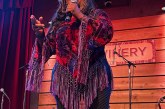Another Big Ears has come and gone.
And just like always, attendees are left with new favorite bands, some of whom probably weren’t even on their schedules to begin with. If you’re a vet of the festival, you know that, other than having a few must-sees, being able to adjust on the fly is key to maintaining a good flow for the weekend. This year’s iteration was no different in this regard.
If the show you planned on seeing was at capacity, there was a venue just down the street that presented another tasty offering. If you ran into friends who were especially honed in on a particular act, altering your plans in favor of theirs almost always paid off, especially if they knew your tastes and could vouch for the artist that was taking you off your plotted course.
Such was the case for our crew throughout the weekend, and we ebbed and flowed from Thursday until múm and Explosions in the Sky put a ribbon Sunday evening on what was another wildly successful festival. The following are a few of our favorites from the final day of Big Ears 2025. – Rusty Odom
“Soundtrack to a Coup d’Etat”
Big Ears didn’t flinch in programming one of 2024’s most revolutionary documentaries, “Soundtrack to a Coup d’Etat,” which closed the film portion of this year’s festival. Academy-nominated for Best Documentary Feature and winner of numerous international accolades, the doc takes audiences back to the era of what should’ve been Congolese independence, the late 1950s to the early 1960s, when jazz ruled the airwaves and – through subterfuge – became an instrument of war.
The film opens at the chronological end of the events being portrayed, interspersing footage from the U.N. Security Council protest led by musicians Abbey Lincoln and Max Roach against the murder (political assassination) of first Congolese prime minister Patrice Lumumba with an introduction to the documentary’s “characters,” including famous jazz musicians and African politicians and revolutionaries, as well as Nikita Khrushchev, then the first secretary of the Communist Party of the Soviet Union. Bold typography and color washes over the footage, making this opener feel almost like credits to a television series, hooking the audience with a fast pace and the reward of great music.
Archival footage makes up what seems to be 100% of the visuals beyond the typography, which is used engagingly throughout to cite quotes, sources, events and dates that contextualize what we’re seeing against the rampant revisionist history that plagues this era. There are no talking heads, no scholars or historians interpreting for the audience how they should feel or internalize this information. Real moments in history make the reality of the situation uncontestable, serenaded by a captivating soundscape of Afro-American and diasporic jazz. These were songs of joy, resilience and freedom that made me want to get up and dance in the aisles.
“Soundtrack to a Coup d’Etat” challenges documentary-filmmaking conventions in many ways, most directly in its creation of characters not through real-time vérité coverage but rather in careful collation of real footage that, when assembled, moves as smoothly as the best fictional plots … except we know it isn’t fiction because all these moments are on the record, in the archives, available to us for however long the free world remains as such.
The work of archivists, researchers, historians and storytellers is more important now than ever in our lifetimes. “Soundtrack to a Coup d’Etat” is an urgent film spotlighting a region still deeply colonized and exploited by Western interests. It’s length and gravity might give you pause, but the superb soundtrack, innovative storytelling and real-life characters will inspire you to see this episode in history newly and invite meaningful introspection for future action.
If you missed it at Big Ears, “Soundtrack to a Coup d’Etat” can be viewed on the Kino Films streaming collection or can be rented on all major platforms. – Amelia Bartlett
Tindersticks
A quiet, rainy Sunday afternoon in the theater district provided an appropriately gloomy pretext for this much-anticipated show at the Tennessee. Introspective, plaintive and patient, this English group’s lounge-ready brand of indie rock might be what one would expect to encounter in a smoky European café, but it translated just as well to the ornate 1,600-seater in downtown Knoxville.
With Stuart A. Staples’ distinctive lilting croon sounding hale and clear as a bell, the five-piece embarked upon a deliberate journey through its 30-year canon of songs. More carefully measured than languid, each note came across as lovingly chosen, whether it occurred during an airy Topicália-inflected number or a brooding rocker. Lefty lead guitarist Neil Fraser put in a standout shift, too, his work on the axe often mesmerizing and adding noticeable depth and heft to the overall performance.
With the exception of an excellent rendition of “Let’s Pretend,” Tindersticks’ recent material was the highlight of the set, indicative of an old band still finding a creative spark, refusing to simply go through the motions and willing to strive to deliver the goods to an audience that would know the difference if it weren’t. – Matt Rankin
Canzoniere Grecanico Salentino
Canzoniere Grecanico Salentino performed my favorite show of the festival. Consisting of six members playing acoustic instruments and a dancer, this was the latest version of a family group that has been around since 1975. The name means Songbook of the Grecanici of Salento, and the band plays folk music from the province of Salento in far southern Italy. The music – featuring bouzouki, frame drums, accordion and violin and sung in Griko, a local variant of Greek – was highly danceable. With some planned choreography, excellent lighting and entertaining banter by Mauro Durante (son of founder Rina Durante), the show was nonstop fun from beginning to end. – Bill Foster
Dedicated Men of Zion
Making a couple of appearances over the weekend, this North Carolina quartet provided some much-needed soul healing with the help of the Knoxville Gospel Choir on Sunday at the Civic Auditorium. With so much heaviness both here and abroad, it was a welcome change to behold such joy and gratefulness for an afternoon. The exuberant audience was dancing and singing throughout the show, and we weren’t alone in stepping out onto the street afterward with renewed hope and energy to face the world’s ills. – Jennifer Duncan-Rankin
Joan As Police Woman
As often happens at Big Ears, scheduling conflicts and capacity alerts will cause you to have to pivot and see an act that was not even on your radar. These factors came into play for me Sunday afternoon, but it luckily allowed me to see multi-instrumentalist Joan Wasser’s project at The Standard. Strolling onstage wearing a beautiful pink dress and bathed in apt lighting, she wasted little time jumping into her first soulful number of the afternoon. Wasser moved between keyboard, baby grand piano and electric guitar before shifting back to the keys to close out the set. Each song featured elements of soul and jazz, impeccable time signatures from drummer Jeremy Gustin and lush accompaniment from Reuben Butchart on bass and Christopher Bruce on guitar.
Wasser told a story midway through the set about how Big Ears creator Ashley Capps saw a recent performance and asked, “Who are you?” She recalled that they exchanged phone numbers, eventually leading to her performing at Big Ears. The unexpected change in plans worked out splendidly for me, as I managed to stay this entire performance, a rarity for me at Big Ears. The payoff was thoroughly enjoyable. – John Flannagan
Rufus Wainwright
With an expansive catalog that spans across multiple genres, Wainwright treated a full KCA to a variety of tunes from his repertoire and even worked in some new material from his upcoming pop album. Save for the introduction of up-and-coming country artist Amber Martin, who joined him on a couple of numbers, the only other accompaniment was Wainwright displaying his skills on guitar and piano interchangeably. Having dual citizenship in the U.S. and Canada, the artist worked in quite a few politically charged messages in his stage banter which, though pointed, was also infused with sharp humor. A truly beautiful and classic performance was capped off with his signature version of Leonard Cohen’s “Hallelujah.” – JDR
múm
Not to reduce the hearty Icelandic music scene to just three acts, but it’s probably fair to anoint Björk, Sigur Rós and múm as the Scandinavian country’s holy trinity. At the very least, they are some of its most prominent exports, musical or otherwise. While Knoxville has yet to host the former two – neither at a Big Ears nor at all, to my knowledge – visitors to the Bijou on Sunday evening experienced a knockout performance by the latter.
As was the case with a few of the artists on this year’s lineup, múm made its festival debut five years after having been booked for the 2020 iteration, which was canceled due to COVID. (Former band members and twin sisters Kristín Anna and Gyða Valtýsdóttir performed at St. John’s during the 2019 edition.) With multiple current members expressing their gratitude both during and after the show for finally having been involved with the fest, it was clear their appearance meant almost as much to them as it did to the capacity crowd gathered inside the city’s best listening room.
Reaching deep into its catalog – and even drawing once from an as-yet-unreleased album – the group justified its inclusion with a varied and engrossing amalgam of tracks representing different periods of its three-decade-long career. It was illuminating to see how these densely layered compositions were crafted, and the live environment fostered a greater appreciation of the band’s instrumentation, as well. Glitchy tracks like “We Have a Map of the Piano” and “Green Green Grass of Tunnel” crackled with the same warmth that blankets the recorded versions, but there was better balance and more robustness to the mix.
This was bucket-list stuff for me, and witnessing it from the spacious lower loggia of my favorite venue in the world made it that much more meaningful. It was about as comfortable of a way of anaesthetizing myself for the painful comedown that always follows these four days of exploration, stimulation, enlightenment and resultant mental and physical exhaustion that I could possibly hope for. – MR







